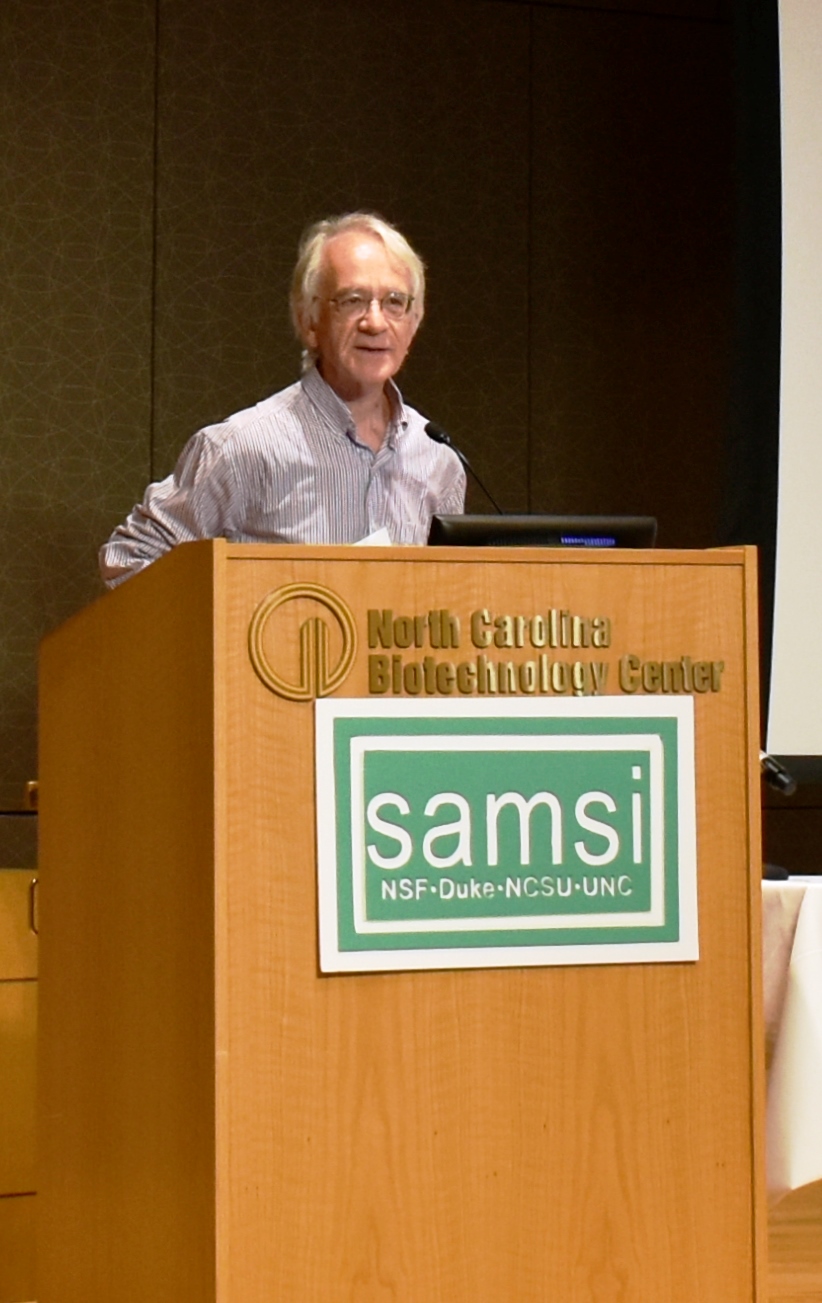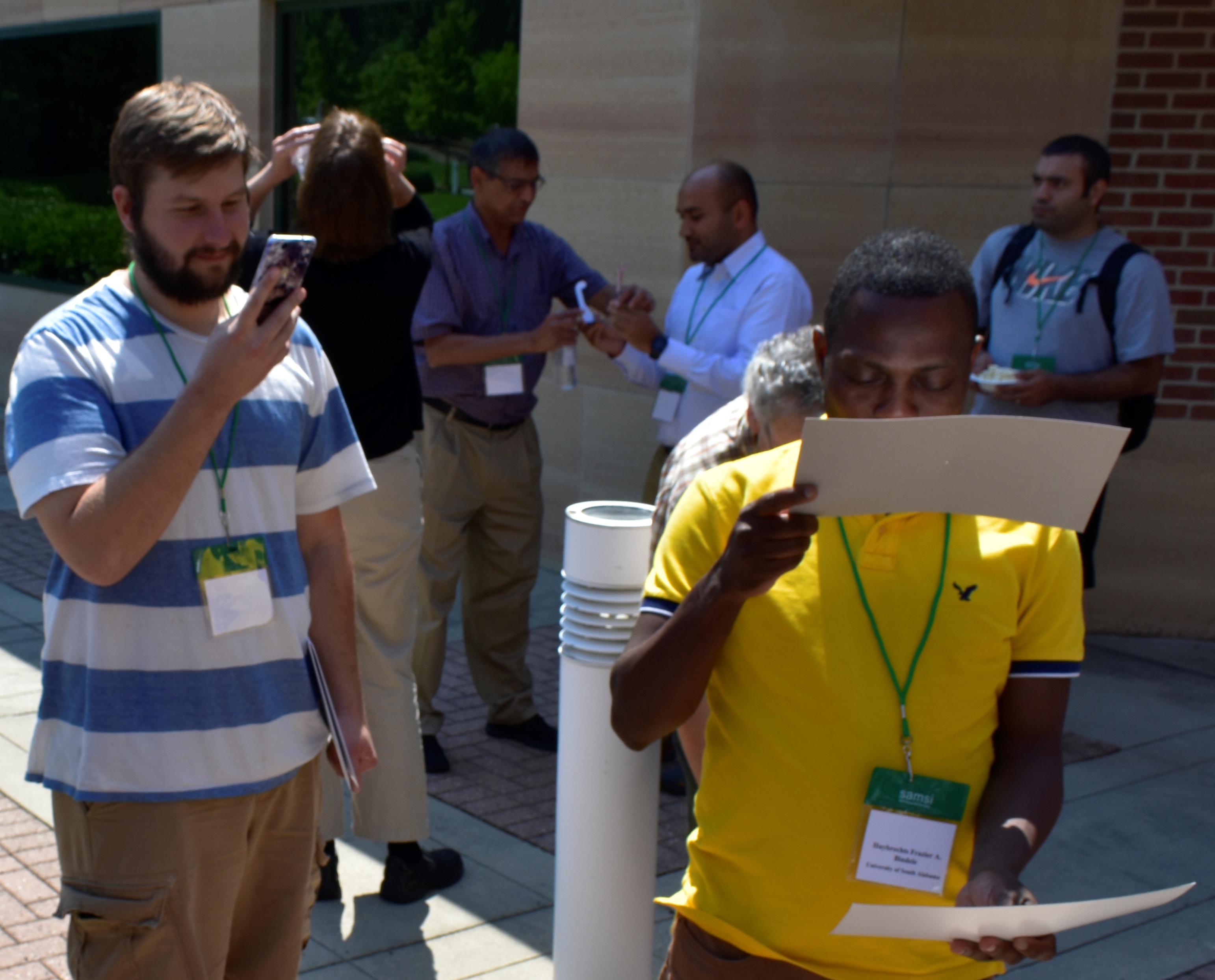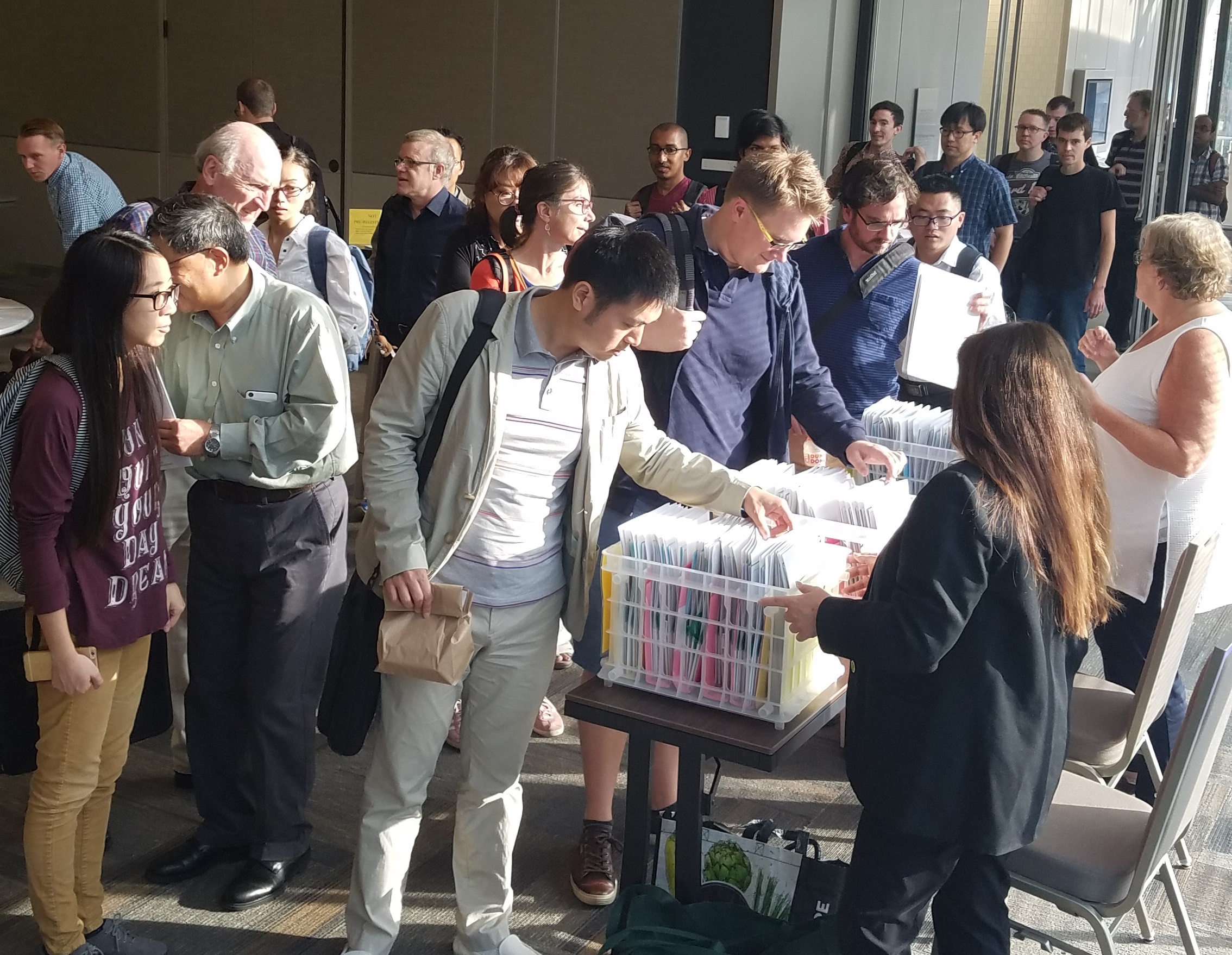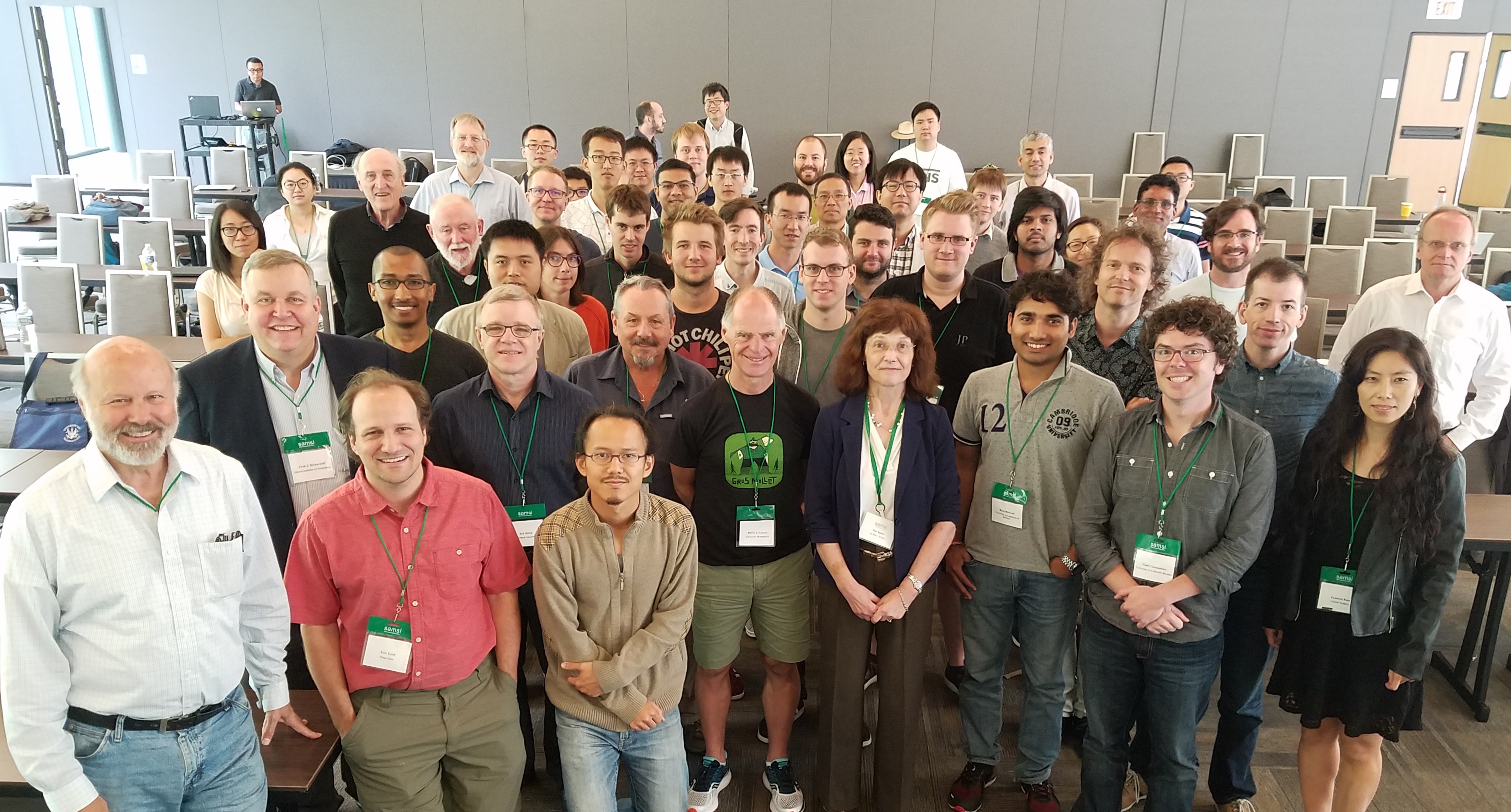
SAMSI Kicks Off 2017-2018 Programs on Environment and High-Dimensional Data Sampling

Richard Smith, Director of SAMSI, opens the CLIM Opening Workshop at the N.C. Biotechnology Center on Aug. 21, 2017. The workshop marks the beginning of the CLIM Program, focused on using data and climate models to analyze environmental changes on our Earth.
Much like universities around the country beginning their fall semesters, SAMSI also kicked off their 2017-2018 year-long programs’ opening workshops: Mathematical and Statistical Methods for Climate and Earth Systems (CLIM) and Quasi-Monte Carlo and High-Dimensional Sampling Methods for Applied Mathematics (QMC) .
Late August was indeed a busy time for SAMSI as the opening workshops occurred in succession during the end of that month. The week-long CLIM Opening Workshop ran from Aug. 21-25 and the QMC Opening Workshop (Aug. 28 – Sept. 1) served as the starting point for both programs.
The CLIM Program looks at analyzing data and climate models to potentially predict future changes on our Earth that could directly impact our environment and the human population. The CLIM Opening Workshop featured many esteemed minds in the study environmental science. The opening workshop led to the creation of 13 working groups, whose overall purpose is to study various factors and data analysis in order to understand how our environment is evolving.
“Climate Science is important for many reasons in our society,” said Richard Smith, Director of SAMSI and Leader of the CLIM Program about the opening workshop. “It is not widely appreciated just how critical the role of mathematical and statistical methods play in climate science.”
More than 120 participants from universities around the world attended the popular workshop. Twenty-five speakers presented lectures on various topics about the science of the environment and how to use mathematical and statistical data to find the root to the causality seen in the modern world. The two panel discussions held during the workshop created much discussion and offered many contributions that led to the creation of the CLIM Program working groups.
The workshop participants were even treated to a rare solar eclipse that occurred over the continental United States during that time. To accommodate this rare event, organizers planned time during the opening day to go out and view the phenomena as it reached the totality phase. Everyone was excited as they used solar eclipse glasses and/or various safe methods to view the eclipse. The last time a solar eclipse could be viewed from the contiguous United States was Feb. 29, 1979. The eclipse was a special occurrence that was a happy coincidence to fall during the workshop and offered a perspective of how much we are shaped by the world around us.
As the opening workshop closed, participants chose the working groups they would be affiliated with for the remainder of the CLIM program. The workshop created valuable network opportunities between the scientists and mathematicians in attendance so that they can continue their research even after the CLIM program ends in May next year.
“This workshop brought together some of the top experts in climate science with the leading researchers in mathematics and statistics,” said Smith. “The lively discussions generated many ideas that will be developed during the rest of this [CLIM] program.”

Participants use multiple safe methods to view a solar eclipse during a break at the CLIM Program Opening Workshop on Aug 21, 2017. The eclipse was a special event that was viewed almost exclusively from the contiguous United States. Organizers planned time during the opening day to go out and view the phenomena as it reached the totality phase. The workshop marks the beginning of the CLIM Program, focused on using data and climate models to analyze environmental changes on our Earth.
The QMC Opening Workshop began the following week, Monday, Aug. 28, and was hosted at the beautiful Penn Pavilion on the campus of Duke University.

More than 110 mathematicians and statisticians check in for the QMC Program Opening Workshop on Aug. 28, 2017, at the Penn Pavilion, on the campus of Duke University. The goal of the QMC Program is to explore the potential of QMC and other deterministic, randomized and hybrid sampling methods for a wide range of applications, including the numerical solution of PDEs; machine learning; computer graphics; Markov chain sampling, like MCMC and MCQMC; sequential Monte Carlo; and uncertainty quantification.
This workshop brought together more than 110 mathematicians and statisticians, who collectively created 10 specific working groups focused on discussing ways in which they would research how to use big data across a wide range of practical applications.
“Kudos to the QMC Program Leaders Art Owen , Frances Kuo , Fred Hickernell and Pierre L’Ecuyer for getting the year-long SAMSI QMC off to a fantastic start,” said Ilse Ipsen, Associate Director of SAMSI and the QMC Program Leader. “Their commitment, combined with spot-on real-time assistance from SAMSI postdocs Cheng Cheng , Matthias Sachs and Whitney Huang , produced this lively Opening Workshop and an unusually large number of 10 promising working groups.”
The goal of the QMC Program is to explore the potential of QMC and other deterministic, randomized and hybrid sampling methods for a wide range of applications, including the numerical solution of PDEs; machine learning; computer graphics; Markov chain sampling, like MCMC and MCQMC; sequential Monte Carlo; and uncertainty quantification.
More than 20 speakers were invited to speak on a wide variety of sampling methods. The talks generated much discussion amongst participants and created the impetus for the working groups that were created.
Overall, the QMC Opening Workshop was well received by the participants and many looked forward to the future meetings in their respective working groups.
“The QMC Program is well on its way to being super-productive,” said Ipsen.
The research that will come from both the CLIM and QMC programs will help to address ways in which we can improve our environment, improve efficiency and productivity through random sampling across various applications, and advance technology. Research and collaboration are how SAMSI works to advance research in statistics and applied mathematics to innovate the future.
To see what was presented at these workshops, visit: www.samsi.info/clim-ow or www.samsi.info/qmc-ow ; to view working groups, visit: www.samsi.info/working-groups .

Mathematicians and statisticians pose for a group photo at the conclusion of the QMC Program Opening Workshop on Sep. 1, 2017, at the Penn Pavilion, on the campus of Duke University. The workshop featured more than 20 speakers and led to the creation of 10 specific working groups focused on discussing ways in which they would research how to use big data across a wide range of practical applications. The goal of the QMC Program is to explore the potential of QMC and other deterministic, randomized and hybrid sampling methods for a wide range of applications, including the numerical solution of PDEs; machine learning; computer graphics; Markov chain sampling, like MCMC and MCQMC; sequential Monte Carlo; and uncertainty quantification.